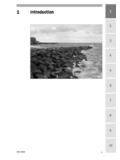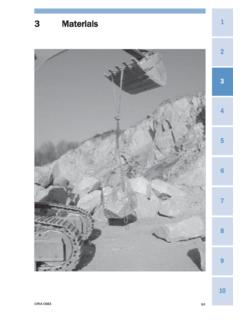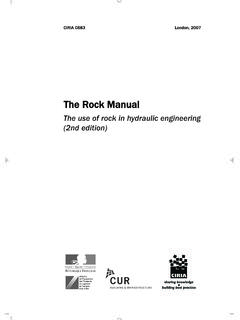Transcription of The Rock Manual - VKC-Water
1 CCIIRRIIAA CC668833 LLoonnddoonn,, 22000077 TThhee RRoocckk MMaannuuaallThe use of rock in hydraulic engineering (2nd edition)TThhee RRoocckk MMaannuuaallCIRIA C683iiThe Rock Manual . The use of rock in hydraulic engineering (2nd edition)CIRIA; CUR; CETMEFCIRIA C683 CIRIA 2007RP683 ISBN 978-0-86017-683-1 DDiissccllaaiimmeerrAll rights reserved. No part of this publication may be reproduced or transmitted in any form or by anymeans, including photocopying and recording, without the written permission of the copyright-holder(CIRIA, CUR, CETMEF), application for which should be addressed to the publisher.
2 Such writtenpermission must also be obtained before any part of this publication is stored in a retrieval system of publication is designed to provide accurate and authoritative information in regard to the subjectmatter covered. It is sold and/or distributed with the understanding that neither the authors nor thepublisher is thereby engaged in rendering a specific legal or any other professional service. While everyeffort has been made to ensure the accuracy and completeness of the publication, no warranty or fitnessis provided or implied, and the authors and publisher shall have neither liability nor responsibility to anyperson or entity with respect to any loss or damage arising from its products mentioned in this book are registered trademarks; for clarification, readersshould consult the manufacturer.
3 The mention in this publication of a proprietary productshould not be taken to imply that the authors or publishers endorse any such tthhiiss ppuubblliiccaattiioonnWhen referencing this publication in other written materials please use the information below:TitleThe Rock Manual . The use of rock in hydraulic engineering (2nd edition)Author CIRIA; CUR; CETMEFDate2007 Publisher C683, CIRIA, LondonExampleUnder the standard Harvard system, the reference should appear as:CIRIA, CUR, CETMEF (2007). The Rock Manual . The use of rock in hydraulic engineering (2nd edition).
4 C683, CIRIA, LondonCIRIA keywordsClimate change, coastal and marine, constructionmanagement, design and buildability, flooding,ground investigation and characterisation,sustainable construction, sustainable resource use,whole-life costing, materials, concrete andstructures, dams and reservoirs, environmentalgood practice, health and safety, refurbishment,rivers and waterways, procurement, risk andvalue management, water infrastructureGeneral keywordsArmourstone, rock, climate change, coastal andmarine, construction, design and buildability,flooding, geotechnics, hydraulics, sustainableconstruction, sustainable resource use, whole-lifecosting, construction materials, quarrying,concrete and structures, dams and reservoirs,environmental good practice, health and safety,refurbishment and repair, river and channels,maintenanceReader interestCoastal, river and estuarine managers andengineers, consultants, civil engineers, hydraulicengineers, geotechnical engineers, engineeringgeologist, environmental regulators,geomorphologists, modellers, planning and otherconsenting authorities, environmental advisers.
5 Contractors, quarry companies, laboratories,academicsClassificationAVAI LABILITYU nrestrictedCONTENTA dvice/guidanceSTATUSC ommittee-guidedUSERC oastal and estuarine managers,consultants, contractors,suppliers, consenting authorities,environmental regulators andadvisers, researchersMMiinniisstteerriiaall ffoorreewwoorrddCIRIA C683iiiMMiinniisstteerriiaall ffoorreewwoorrddOur ports, coastal and river defences and inland waterways are vital to the maintenance oftrade and economic development. Natural and durable rock is one of the main materialsemployed in marine and river construction works to prevent scour and erosion, and to limitwave overtopping and flooding.
6 It is estimated that at least 10 million tonnes of armourstoneare used each year across Europe, in construction works valued at nearly 1 billion. Yet manyengineers still employ traditional techniques in the use of rock and fail to gain the benefits ofindustry experience and new research. They also need guidance to ensure that the projectsthey conceive are environmentally friendly and national governments realised there was a need to sponsor the production of a singlereference source on good practice in the use of rock in hydraulic engineering, drawing onthe expertise of the limited number of real experts across Europe.
7 The project to producethis Manual is therefore, very appropriately, the fruits of collaboration between threecountries in the European Union: France, Netherlands and United new Manual is more than a revision of existing documents. It is based on two full yearsof effort by an unique team of international experts. They have put together a extensivesummary of good practice on the use of rock in engineering works for our rivers, coasts andseas and have incorporated all the significant advances in knowledge that have occurred overthe past 10 15 years. It is our belief that application of the guidance in this Manual will helpto achieve a long-term improvement in the use of armourstone and will promote conservationof natural systems in balance with the proper protection of human life and therefore have pleasure in commending this document to all those interested in thesubject including public authorities commissioning work, designers and PearsonMinister of State, Departmentfor Environment, Food andRural Affairs, United KingdomG CaudeDirector of Institute forMaritime and InlandWaterways, FranceL H (Bert)
8 KeijtsDirector-General for PublicWorks and WaterManagement, NetherlandsTThhee RRoocckk MMaannuuaallCIRIA C683ivSSuummmmaarryyIn 1991 CIRIA/CUR produced the Manual on the use of rock in coastal and shoreline engineering,commonly referred to as The Rock Manual (CIRIA, 1991). CUR/RWS updated the book in1995 to include the use of rock in dams, fluvial engineering and construction (CUR, 1995).Two French reference books were produced in the late 1980s: Le dimensionnement des digues talus(EDF R&D, 1987) and Les Enrochements(LCPC/CETMEF, 1989). Since publication ofthese earlier reference texts significant research has been done to improve understanding ofrock behaviour and to determine improved practices for hydraulic engineering.
9 Consequently,this Manual has been developed to bring the earlier publications up to date and has beengiven a broader scope that increases the focus on environmental and sustainability information incorporated in this edition includes: extended scope of the Manual (from the 1991 edition) to cover coastal , inland waterwayand closure structures guidance on design and construction using concrete armour units updated guidance on armourstone specification and model construction specification forrock structures cross-referencing to the new European armourstone specification EN 13383, whichsupersedes sections of the previous manuals extensive cross-referencing to the Eurocodes for geotechnical considerations new research on block integrity, packing and placement.
10 Predicting quarry yield andblock size distributions a new risk assessment template updated guidance on wave overtopping, wave run-up and wave transmission updated guidance on wave climate description and representative wave parametersincluding wave height distribution in shallow waters updated guidance on the selection of hydraulic design conditions, including design withjoint probabilities of, for example, waves and water levels updated guidance on river hydraulics and design conditions for river structures updated guidance on the performance of falling aprons updated guidance on stability of low-crested structures, toe protection to verticalbreakwaters, calculating wave forces on crown elements and on the stability of rock-armoured slopes with shallow foreshores new guidance on rear-side stability of rock structures, on the stability of near-bed rockfillstructures.









